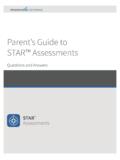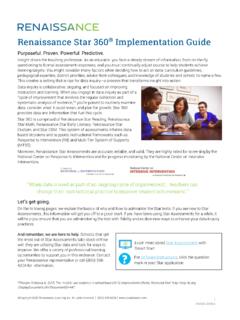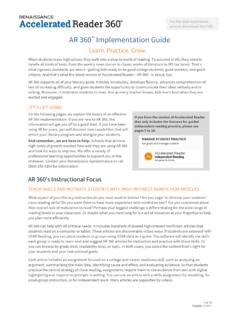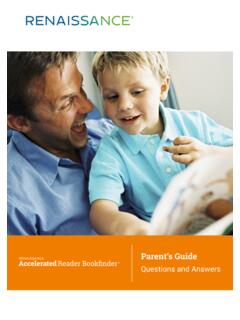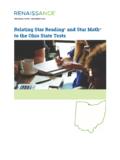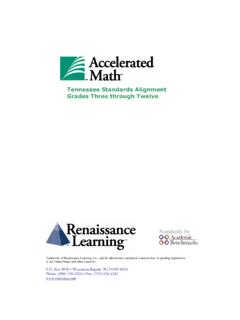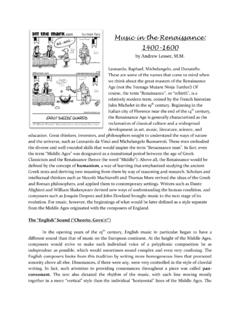Transcription of 20 Report 12 - Renaissance Learning
1 IntroductionTeachers share a common goal in trying to help students become lifelong learners who love to read. In order to achieve this, students must devote time to reading appropriate literature (Anderson, Hiebert, Scott, & Wilkinson, 1985; Lewis & Samuels, 2003; Samuels & Wu, 2004; Snow, Burns, & Griffin, 1998). However, simply setting aside time for reading is not sufficient; the time must be well spent. Teachers should ensure that students experience a high level of success in their reading practice. Key to ensuring success in reading is to personalize student practice, set goals for that practice, and provide a means to monitor progress toward those goals. The Accelerated Reader (AR) software a computerized, personalized practice and progress-monitoring system makes all of this possible. Following AR Best Practices, Renaissance Learning s research-based principles that ensure fidelity of implementation, there are three components to goal setting with Accelerated Reader: quality of reading practice (level of success or percent correct), quantity of reading practice, and ATOS book level1 ( , book readability level, challenge level).
2 The AR software and Accelerated Reader Goal-Setting Chart (see Appendix, p. 6) work together to facilitate setting appropriate, individualized reading practice goals for each student for average percent correct on AR Reading Practice Quizzes, quantity of AR points earned (an indication of the amount of time a student has been engaged in reading practice), and average ATOS book level. The guidelines found in the Goal-Setting Chart are supported by research and have been validated empirically. When combined with an educator s professional judgment, they help to ensure the best outcomes for all Percent Correct GoalResearch shows that high levels of success in academic tasks lead to improved educational outcomes, including large gains in reading achievement (Allington, 1984; Betts, 1946; Rosenshine & Stevens, 1984). In addition, research has found high rates of success are more critical for low-achieving students than for high-achieving students and have more significant effects on achievement than engaged time on task (Marliave & Filby, 1985).
3 In Accelerated Reader, level of success in reading practice is measured by percent correct on AR Reading Practice Quizzes. Validated by Topping and Sanders (2000), AR Best Practices recommend students average 85% correct or higher. Additional researchers confirmed the 85% correct recommendation by analyzing the reading practice and achievement of more than 40,000 students (Borman & Dowling, 2004; Paul, 2003). Averages of 90% and higher were associated with even greater gains. Results showed that percent correct on AR Reading Practice Quizzes was more important to student reading achievement than amount of reading or book readability levels. At all achievement levels, students experienced greater normal curve equivalent (NCE) gains as percent correct increased (see Table 1, next page).The Research Foundation for Accelerated Reader Goal-Setting PracticesReport2012 JanuaryContentsIntroduction ..1 Average Percent Correct Goal ..1 ZPD and ATOS Book Level Goals.
4 2 Point and Time Goals ..4 Appendix: Accelerated Reader Goal-Setting Chart ..6 References ..71 ATOS book levels are determined using Renaissance Learning s scientifically-based ATOS for Books Readability Formula. For more information, see Milone, 2009. 2 Table 1: Students Experience Greater NCE Gains as Percent Correct Increases Grades 2 12 (N = 45,670)ZPD and ATOS Book Level GoalsWhat is ZPD?A ZPD or zone of proximal development is a theoretical concept introduced by the Russian child development psychologist Lev Vygotsky (1978) that has been translated into the realm of guided independent book reading with the development of ZPD ranges. When students read within their individual ZPD ranges, the portion of the text they know helps them understand the unknown portion of the text (Paul, 1996). In independent, literature-based reading, a ZPD is the range of books that will challenge a student without causing frustration or loss of motivation.
5 The Accelerated Reader Goal-Setting Chart (p. 6) includes suggested ZPD ranges educators can use as guidelines when setting reading goals with influencing ZPD rangesTo initially determine a student s ZPD range, a teacher will use results from a standardized test of general reading achievement such as the computer-adaptive STAR Reading assessment2 to match the student s GE score to a ZPD range on the Goal-Setting Chart. Then, the teacher monitors the student s comprehension of books read within that range by checking the results of AR Reading Practice Quizzes and frequently conferencing with the student (via an AR routine called Status of the Class3). Educators should use what they know about each student s level of reading achievement and appetite for challenge, as well as professional judgment, to set appropriate reading practice goals. If a student is struggling to maintain an average of 85% correct on AR Reading Practice Quizzes, the educator may need to suggest other options to the student, such as reading a shorter book, a book with a lower readability level, or a book on a particular topic of interest.
6 Likewise, a teacher may expand a student s ZPD range if he/she is especially interested in reading certain books above the current range, and the teacher feels confident the student has a good chance of reading them with comprehension. For lower grade-equivalent (GE) scores, the Goal-Setting Chart provides slightly narrower ZPD ranges to ensure that emergent readers are not frustrated by material that is too challenging. Educators should determine whether these students are capable of reading slightly more difficult books independently, or if support should be provided through activities such as reading a book to or with a student. For higher GE scores, the Goal-Setting Chart ranges are wider to reflect the fact that much good literature contains content appropriate for upper-level students even though it may not be written at high readability levels. For example, The Crucible, by Arthur Miller, has an ATOS book level of , yet the ideas and themes of the play are appropriate for upper-level, advanced readers.
7 2 The norm-referenced STAR Reading assessment is reliable and valid and allows educators to quickly and accurately assess reading scores for students in grades 1 Teachers implementing AR Best Practices use Status of the Class to monitor and guide reading practice by conferencing daily with students to offer support and praise. Student Achievement Level(Percentile Range)Average Percent Correct RangeBelow 65%65% 74%75% 84%85% 94%95% 100%0 20 40 60 80 100 from Paul, 2003 NCEs are a way of representing percentile scores so that they can be accurately averaged and compared with each other. Because NCEs are derived from percentiles, they measure growth in comparison to national norms. Positive NCE gains mean student achievement grew at a faster rate than national averages. An NCE gain of zero represents the national 2: Comparison of Actual Student Reading to ZPD Ranges on AR Goal-Setting ChartPlease note: Book readability is not a measure of content appropriateness.
8 In fact, many books with lower readability levels (such as The Crucible) contain content more suitable for older readers. Decisions on the appropriateness of books for particular students are left to the judgment of educators and parents. Renaissance Learning classifies each book that has an AR Reading Practice Quiz with an interest level that refers to the sophistication and maturity level of a book s content, ideas, and themes: LG = lower grades (K 3), MG = middle grades (4 8), MG+ = middle grades plus for more mature middle-grade readers (6 and up), and UG = upper grades (9 12). Interest levels are based on publisher recommendations and should be used in concert with a book s readability level to determine if a book is appropriate for a student to read. To develop automaticity and gain knowledge from reading, as well as learn new vocabulary, students must read a large quantity of literature (Pressley, 2000). If a student s ZPD range is too narrow, the range of books available to read is limited, as is the opportunity to experience the successful reading practice that is so vital to improving reading of ZPD rangesThe ZPD ranges found on the Goal-Setting Chart were developed using actual student reading data and are updated on an ongoing basis.
9 The current ranges were validated based on data from more than 20,000 students during the 2001 2002 school year. Table 2 shows the typical range of books read by students in Renaissance Learning -certified Model and Master Schools4 compared to the Goal-Setting Chart ZPD ranges. The data show that the typical range of books read is consistent with the Goal-Setting Chart. Grade-Equivalent ScoreNumber of StudentsReadability-Level Range of Most Books Read by StudentsGoal-Setting Chart Suggested ZPD , , , , , , , , , , Renaissance Certification is a professional recognition program for educators who implement Accelerated Reader and/or Accelerated Math according to Renaissance Learning s research-based Best Practices. There are two levels of certification: Model Certification, which confirms that recommended practices are being implemented correctly and students are receiving ample quality reading practice time; and Master Certification, which challenges educators to excel even and Time GoalsAR pointsThe amount of reading practice students receive is highly correlated to reading achievement gains (Anderson, 1996), but research has shown that it is not just the amount of time allocated to an activity that predicts student achievement.
10 Rather, it is the amount of time in which a student is successfully engaged in activities related to valued educational outcomes (Berliner, 1991; Fisher et al., 1980). This time is called academic Learning time (ALT), and it is a critical contributor to academic growth (Batsche, 2007; Berliner, 1991; Gettinger & Stoiber, 1999; Karweit, 1982). Four components distinguish ALT from simple measures of classroom time or time on task : (1) Students are actually engaged with the material; (2) the material is at the proper level of challenge , in their zone of proximal development; (3) students experience a high rate of success; and (4)both the student and teacher receive regular feedback about performance. AR points are a powerful tool educators can use to measure ALT for reading. In Accelerated Reader, points are computed based on the readability level of and number of words in a book. Students earn a portion of a book s points depending on how well they perform on the AR Reading Practice Quiz.
